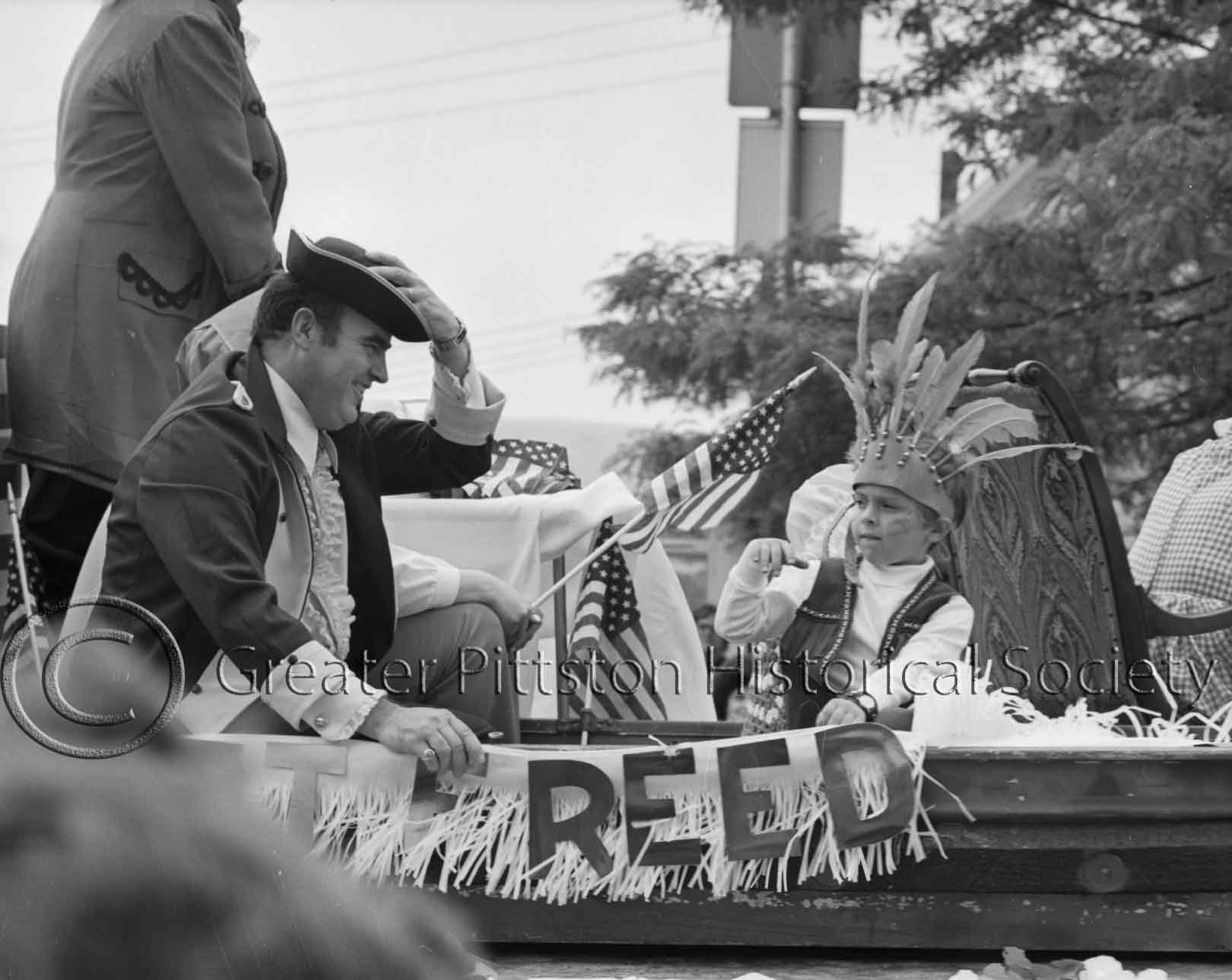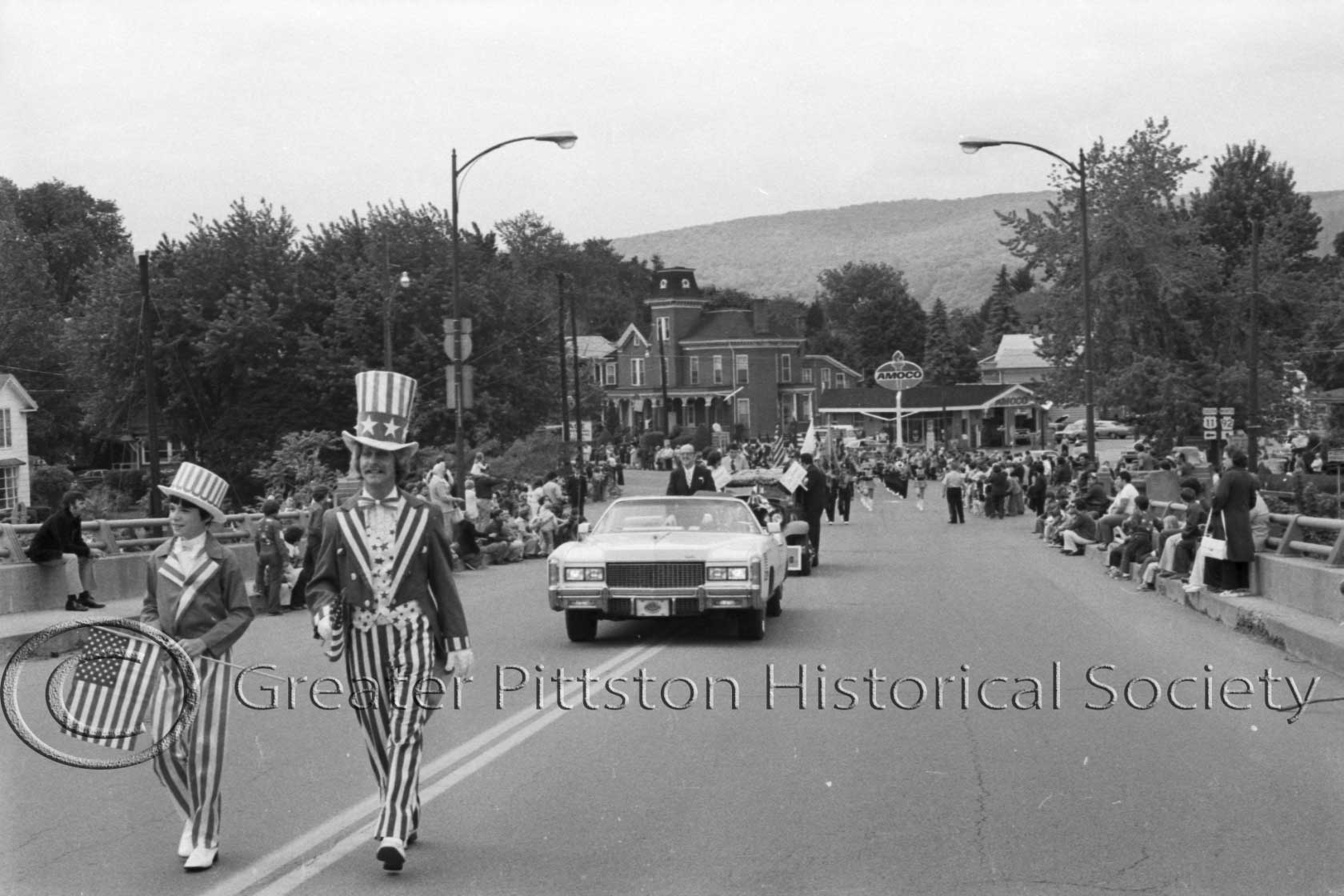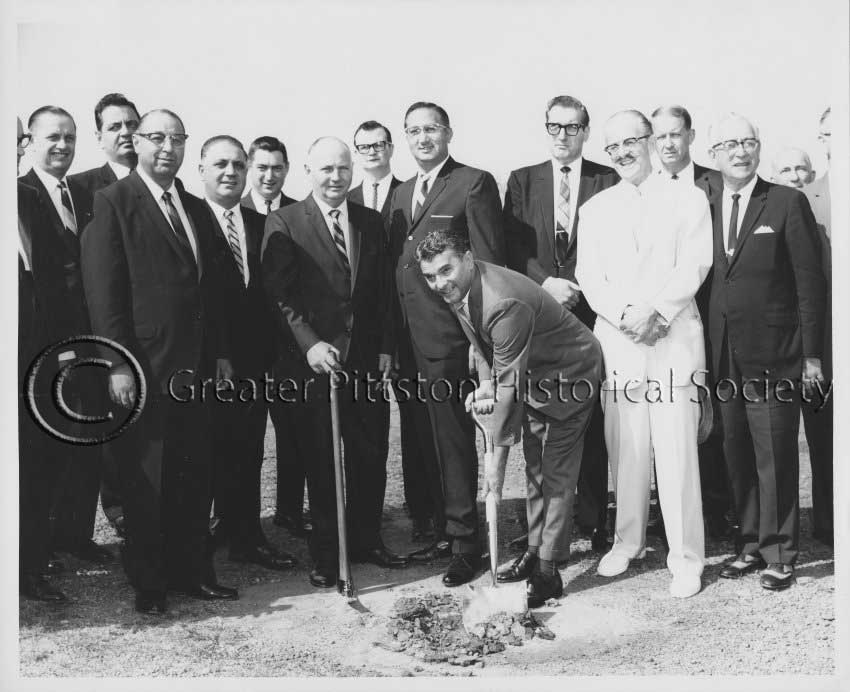There is a rich history of patriotism and politics in this area of the Wyoming Valley. As a key industrial region throughout the twentieth century, many presidential candidates made a point to visit the area while on the campaign trail. In fact, the region’s importance stretches back to the American Revolution, when an important battle took place in this valley. Pittston area residents have long cherished their region’s contributions to the Revolutionary conflict, demonstrating their nationalism and patriotism through pride in their history. On either side of the Susquehanna River, Fort Pittston and Fort Jenkins held troops during the Revolutionary War. In Wyoming, there was an incident where many local militiamen were killed by a combined British and Native American force. This event has become known as the Wyoming Massacre.
Though the Revolutionary War would be the last time there would be battles within the area, residents of this area have shown their patriotism in a variety of ways. Many joined the military, or an auxiliary such as the Merchant Marine and Civil Air Patrol. Also, many grew Victory gardens, bought and promoted war bonds, and gave to various drives (scrap metal and rubber for example) during the First and Second World Wars. For the bicentennial celebration of the American Revolution in 1976, there were parades and celebrations of patriotism held in Pittston throughout the year.
The Greater Pittston area has also been an active participant in the world of politics. Going at least as far back as Theodore Roosevelt, many presidents have visited this valley, for campaigning reasons, recognizing the importance of connecting with its residents. In later years (and with the innovation of air travel), with Luzerne & Lackawanna Counties’ major airport being located in the area, every president since 1948 that has flown in for visits to Wilkes-Barre and Scranton has had to arrive through the Greater Pittston area. Pittston has also offered many native sons to federal and state politics, including Congressional Representative Daniel J. Flood (who was not from Pittston but he did represent Pittston in Congress), who served for 15 terms, and State Senator Raphael Musto.
The media often plays a role in politics as well, and the City is once again represented by two newspapers, both weeklies, the Sunday Dispatch and the Greater Pittston Progress. This had not been the case in Pittston since the 1960s, when the Pittston Gazette, a daily newspaper, ceased publication. Up until last year, the Dispatch was the sole newspaper representing the entire Greater Pittston area, and sometimes across the county line into Lackawanna County, with sporadic coverage of Moosic and Old Forge. In fact, many of the images in this exhibit come from the Sunday Dispatch’s archive, with the rest coming from the Lukasik Studio Collection, the owners of which also took photos for the Dispatch on many occasions. The Dispatch was pretty evenhanded in its political endorsements under John C. Kehoe’s ownership. The Gazette also appeared to be non-partisan throughout its history, at various points giving equal press to candidates of both major parties. Patriotism and politics have always been a part of life in the Greater Pittston area, going all the way back to the war that created this nation. These two things have both helped shape this area. These are both important aspects, as are all of the sections in this online exhibit, to understanding the Greater Pittston area and its history.
—Matt Gromala
West Pittston’s Float

Caption: West Pittston Float for the Pittston Bicentennial Parade, 1976. Sunday Dispatch Photographic
Collection (1976.1.0249), Greater Pittston Historical Society, Pittston, PA.
In 1976 the United States erupted with celebratory marches, programs, and displays commemorating the 200th anniversary of the signing of the Declaration of Independence. Across the country, Americans praised the legacy of the Founding Fathers, using costumes and decorations to echo their pride for the United States.
The Bicentennial celebrations were just as celebrated here, in Greater Pittston. There were parades and celebrations at historical sites throughout Northeastern Pennsylvania, including the main Luzerne County parade in Wilkes-Barre and the celebrations at the Wyoming Monument (marking the site of the Revolutionary War Battle of Wyoming), the Bloody Rock (purported scene of the Wyoming Massacre) and the Swetland and Dennison Houses (where colonial life in the home is demonstrated by volunteers).
The theme for all of these bicentennial parades and programs in the area was “200 Years…Rediscover the American Dream”, according to an article from the Hazleton Standard-Speaker, originally published Saturday, July 5th 1975. Praising the history of the region, the article describes the Swetland House as being, “built in 1796 and reveal[ing] the way of life and family growth from 1796 to 1864,” and the Dennison House as, “the oldest in Wyoming Valley.”
There was an especially large parade that spanned both sides of the Susquehanna River in the Greater Pittston area, in the summer of 1976. The parade began on the West Pittston side of the river, and made its way across the Fort Jenkins Bridge into Pittston, near the Junction section. It then wound up through the City of Pittston by way of Main Street, at least as far as the forks of the road leading into Port Griffith in Jenkins Township. This parade was notable for the amount of floats and groups participating. There were scout troops (both boy scouts and girl scouts), Cub Scout packs, and civic groups such as Kiwanis and the Lion’s club. There were also veterans groups, such as the American Legion, as well as business-related groups, including the Telephone Pioneers of America, a charitable organization founded in 1911 out of employees of the telecom industry. From the organization’s website, “The major goals were to perpetuate the ideals and traditions of the industry and promote the fellowships that were formed as a natural result of their teamwork.” High school marching bands and color guards were even represented, including from as far away as Montoursville Area High School. Also there were floats from some of the townships and boroughs that participated, including Duryea and West Pittston. In this photo one can see a float for West Pittston, and the crowd on the sidewalk watching the parade. The businesses that lined Main Street are also visible. Many of the businesses and restaurants lining the streets in this photograph are no longer there, which allows the image itself to serve as a sort of time-capsule for life in Pittston in 1976.
—Matt Gromala
Remembering Colonial Heritage

Pittston Bicentennial Parade, July 4, 1976. Sunday Dispatch Photographic Collection
(1976.1.1058), Greater Pittston Historical Society, Pittston, PA.
American July Fourth celebrations have been an important patriotic tradition throughout our nation’s history. The 1976 celebration was a milestone July Fourth for the United States as it commemorated the bicentennial anniversary of the Declaration of Independence. All across the country, major cities like New York and Philadelphia and small towns such as Wyoming and Pittston (Pennsylvania) put on major events such as parades to reinforce to paramount aura that surrounds such a milestone as the Bicentennial.
The American Bicentennial came during a very stressful and controversial time. Events such as parades and large-scale social gatherings helped divert attention away from the protests and troubles that the previous decade (the 1960s) had shown the American People. The Vietnam conflict, the infamous Watergate scandal just a few years prior resulting in the ousting of President Richard Nixon, and the Civil Rights movement had applied much stress to the everyday lives of many Americans for the first time since World War II.
Parades such as this one show Americans of all ages participating in the fun and excitement of the biggest Fourth of July celebration in living memory. This image represents a parade float carrying individuals dressed in traditional colonial attire, as the viewer can see a middle-aged man adjusting a three-point hat, a common choice of hat throughout the eighteenth century. A young boy, no more than a child, can be seen adjacent from the middle-aged man dressed in Native American attire as cured leather and a feathered headdress celebrating the heritage of those who populated the land before the colonization of the New World. American flags are spread across the float signifying the holiday. Smiles and laughter seem to fill the faces of the parade participants. The aura of the event gives a strong sense of jubilation — evidence of the pride of the Pittston people in their country’s heritage. President Gerald R. Ford made a national announcement from our nation’s capital summarizing the good and the bad that these two-hundred years had brought:
“For two centuries our Nation has grown, changed and flourished. A diverse people, drawn from all corners of the Earth, have joined together to fulfill the Promise of Democracy… The Bicentennial offers each of us the Opportunity to join with our fellow Citizens in honoring the Past and preparing for the Future in Communities across the Nation.”
—Mike McDonnell
Playing Uncle Sam
During the 1970s, men and women of the Wyoming Valley embraced the renewal of patriotism that the Bicentennial had brought. One man in particular, a longtime teacher who began teaching English at Wyoming Area High School in 1969, chose to show his pride by donning a costume of Uncle Sam for the Bicentennial parade, as many others likely did in cities across the US. PJ Melvin graduated King’s College earning a degree in sociology and English education. Melvin holds a graduate degree from the University of Scranton and would eventually be named principal of Bishop Hafey Junior-Senior High School in 2002. In this image from the Pittston Sunday Dispatch, PJ Melvin marches in the Bicentennial parade dressed as Uncle Sam. PJ Melvin had a voice in the community, like his attire, that stood out for many years. Patriots like Melvin are very important to small town communities. Melvin, having a loud voice in the local politics scene, was a staple for many years as he specialized in representing and defending all matters of education.

P. J. Melvin marching in Pittston’s parade to mark the American Bicentennial, 1976. Sunday Dispatch Photographic Collection (1976.1.0222), Greater Pittston Historical Society, Pittston, PA.
The imagery of Uncle Sam is revered by Americans of a tough, wise man dressed in a red, white, and blue suite featuring a top hat that is usually shown with stars. Uncle Sam emerged as a personification for the US gradually in the nineteenth century, slowly replacing the feminine “Columbia,” which had represented the New World in figurative illustrations since the sixteenth century. Uncle Sam’s popularity as a figure of government was likely cemented during World War I, when artist James Montgomery Flagg used him in an army recruitment poster. Costumes of Uncle Sam, like American flags and other stars-and-stripes-donned objects, would have been hot commodities during the Bicentennial.
—Mike McDonnell
Local Politics and Dan Flood

Caption: Congressman Daniel J. Flood and other local dignitaries, as a ground-breaking
ceremony near Pittston, c.1970-1980. Lukasik Studios Collection, Greater Pittston Historical
Society, Pittston, PA.
The image above shows United States Congressman Daniel J. Flood (here he is at a ceremony to break ground at a construction site), who represented the Wyoming Valley in the United States House of Representatives for several decades. Dan Flood was born November 26th, 1903, in Hazleton, PA. Flood, like many politicians in the Wyoming Valley, got his start in the unions, as an attorney for the garment workers union, which at one point had enough factories to sustain a garment district in the City of Pittston. Flood was also an aspiring thespian, appearing in plays for the Little Theatre of Wilkes-Barre, alongside future Poltergeist actor James Karen.
Though Flood’s political career ended amidst a corruption scandal, that did not largely change the opinion of him in the Valley, including the Greater Pittston area. Since he brought hospitals, airports, and federal money into this area he was viewed in a mostly positive light by his constituencies, who largely continue to credit him with the success of relief efforts after Hurricane Agnes in 1972, despite his relatively minor authority in the matter. Nevertheless, Flood did do much good for this valley during his time in Congress. He was responsible for a VA Hospital coming to Wilkes-Barre, for getting the airport designated an International airport, and for bringing in federal money to rebuild the Valley after Agnes. He fought for his constituency while in Washington D.C., using his influence there to gain favorable programs that would help the Wyoming Valley transition after the decline of the anthracite coal industry in the mid-twentieth century.
Dan Flood would ultimately serve 15 terms in the United States House of Representatives. Flood was known as a sharp dresser, often being photographed in bright white suits and white leather shoes. He was part of a time in American Politics where even national politicians really got to know their constituency. Flood never missed an opportunity to be among the people of the Wyoming Valley — especially if it could improve public relations — which increased his visibility and recognition with the electorate. He would appear in numerous parades, at ground-breaking ceremonies for structures, graduations, and other public events. During Hurricane Agnes in 1972, he stood on the banks of the Susquehanna River, and, as scholar William Kashutas noted “’ordered the Army Corps of Engineers not to allow the Susquehanna River to rise one more inch.’ It never did. Nobody argued with Dan Flood. Not Agnes, not the army, nor — at times, it seemed — the Almighty himself.” One of the largest events that brought about Flood’s downfall was a US Department of Defense contract for missile heads that he awarded to Medico Industries, whose owner had ties to mafia boss Russell Bufalino. Ultimately, Dan Flood was censured by his fellow Congressmen for bribery and resigned from the House of Representatives in 1980. Though Flood was never convicted of a single crime, he plead “no contest” to bribery charges, to avoid a lengthy trial. He always maintained his innocence in the charges, until his death in Wilkes-Barre in 1994. It is often argued that Flood was a victim of the post-Watergate mistrust of politicians nationwide by the courts and the public, when political transgressions were not tolerated. It speaks volumes of his reputation with the area’s residents, however, that in the years since his resignation, not once has anyone raised the issue of renaming an elementary school in Plains Township bearing Dan Flood’s name.
—Matt Gromala
Sources:
Kashatus, William C. Dapper Dan Flood The Controversial Life of a Congressional Power Broker. University Park, PA: The Pennsylvania University Free Press, 2010.
http://www.fordlibrarymuseum.gov/museum/ArtifactCollectionSamples/Bicentennial.html
http://siris-artinventories.si.edu/ipac20/ipac.jsp?uri=full=3100001~!299764!0
http://archives.timesleader.com/2002/2002_11/2002_07_26_LOCAL_BRIEFS.html
http://www.pittstonpolitics.com/news.php?viewStory=211
http://www.loc.gov/pictures/item/96507165/
Mining the Past Business & Industry Entertainment & Leisure Religious & Family Life
